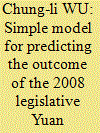| Srl | Item |
| 1 |
ID:
113304


|
|
|
|
|
| Publication |
2012.
|
| Summary/Abstract |
The impact of local campaigning on voter choice has been studied within the theme of mobilisation. Grassroots effort can attract votes efficiently, but campaign contact is (potentially) endogenous, so results showing positive effects could be flawed. Experimental solutions to this problem are possible, but could also have low external validity. Drawing on the electoral geography literature, this article suggests that endogeneity concerns can be addressed through so-called 'friends and neighbours voting'. One source of endogeneity is that that candidates may tend to canvass those living close to their own homes, and those canvassed would be expected in any case to be prone to support local candidates. The problem of endogeneity is reframed and treated as an omitted variable bias. Using unique Irish data on the geographic location of the homes of candidates, as well as data on the location of the voters, the analysis confirms that canvassing has a positive impact on candidate choice independent of the effect of geographic distance. More importantly, these two variables interact. The results point to the relevance of the geographic dimension of electoral politics in driving the endogeneity bias in local campaigning studies.
|
|
|
|
|
|
|
|
|
|
|
|
|
|
|
|
| 2 |
ID:
086456


|
|
|
|
|
| Publication |
2008.
|
| Summary/Abstract |
The 2008 Legislative Yuan elections in Taiwan were held under a new electoral system, a combination of single-member districts with a plurality system, the national nonpreferential list proportional representation system, and the single nontransferable vote system for the aboriginal districts. This work develops a forecasting model and hypothesizes that the partisan voting behavior of Taiwan's citizens largely remains identifiable and durable. There are two methodologies used in this study. The first is the use of three-wave aggregate-level electoral data to estimate the outcomes of the 2008 legislative elections. The second employs ordinary least squares (OLS) estimations to evaluate the effects of previous three-wave electoral results on the 2008 elections. Using the first method, the forecast success rate is more than 80 percent. The findings also reveal that the OLS model performs satisfactorily because two of the three coefficients reach statistical significance. This study concludes by listing three implications of the election: that it was a critical watershed in Taiwan's politics, that there is a geopolitical gap between the north and south, and that minor political parties were eliminated from Taiwan politics.
|
|
|
|
|
|
|
|
|
|
|
|
|
|
|
|